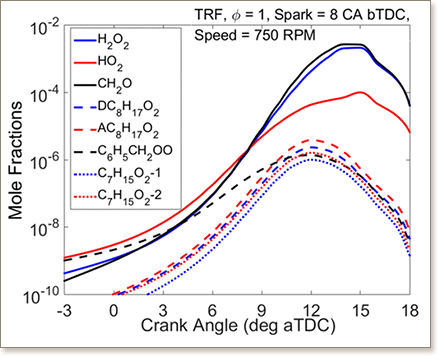Chemical kinetic modeling study on the influence of n-butanol blending on the combustion, autoignition, and knock properties of gasoline and its surrogate in a spark-ignition engine


The ability of a mechanism describing the oxidation kinetics of toluene reference fuel (TRF)/n-butanol mixtures to predict the impact of n-butanol blending at 20% by volume on the autoignition and knock properties of gasoline has been investigated under conditions of a strongly supercharged spark-ignition (SI) engine. Simulations were performed using the LOGEengine code for stoichiometric fuel/air mixtures at intake temperature and pressure conditions of 320 K and 1.6 bar, respectively, for a range of spark timings. At the later spark timing of 6° crank angle (CA) before top dead center (BTDC), the predicted knock onsets for a gasoline surrogate (TRF) and the TRF/n-butanol blend are higher compared to the measurements, which is consistent with an earlier study of ignition delay times predicted in a rapid compression machine (RCM; Agbro, E.; Tomlin, A. S.; Lawes, M.; Park, S.; Sarathy, S. M. The influence of n-butanol blending on the ignition delay times of gasoline and its surrogate at high pressures. Fuel 2017, 187, 211–219, 10.1016/j.fuel.2016.09.052). The discrepancy between the predicted and measured knock onsets is however quite small at higher pressure and temperature conditions (spark timing of 8° CA BTDC) and can be improved by updating a key reaction related to the toluene chemistry. The ability of the scheme to predict the influence of n-butanol blending on knock onsets requires improvement at later spark timings. The simulations highlighted that the low–intermediate temperature chemistry within the SI engine end gas, represented by the presence of a cool flame and negative temperature coefficient (NTC) phase, plays an important role in influencing the high-temperature heat release and, consequently, the overall knock onset. This is due to its sensitization effect (increasing of the temperature and pressure) on the end gas and reduction of the time required for the high-temperature heat release to occur. Therefore, accurate representation of the low–intermediate temperature chemistry is crucial for predicting knock. The engine simulations provide temperature, heat release, and species profiles that link conditions in practical devices and ignition delay times predicted in a RCM. This facilitates a better understanding of the chemical processes affecting knock onsets predicted within the engine and the main reactions governing them.
DOI: 10.1021/acs.energyfuels.8b00962

"KAUST shall be a beacon for peace, hope and reconciliation, and shall serve the people of the Kingdom and the world."
King Abdullah bin Abdulaziz Al Saud, 1924 – 2015
Thuwal 23955-6900, Kingdom of Saudi Arabia
© King Abdullah University of Science and Technology. All rights reserved